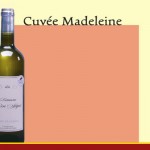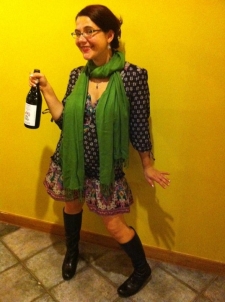 I have never been a big fan of clubs or cliques as I feel like they limit people from amazing experiences… and there is one such club in the wine world that DRIVES ME NUTS!!! That is the ABC Club, AKA the Anything But Chardonnay Club.
I have never been a big fan of clubs or cliques as I feel like they limit people from amazing experiences… and there is one such club in the wine world that DRIVES ME NUTS!!! That is the ABC Club, AKA the Anything But Chardonnay Club.
I am going to say it: I am a Sommelier and I am absolutely bat-shit crazy in love with Chardonnay, and I love it in all its forms.
That is correct, there are many different forms of Chardonnay, not just the over-oaked, toasty, buttery Chardonnay from CA that is the bane of the ABC club, and has also achieved the absolutely fabulous name of “Cougar Juice”.
Let’s go back to the beginning of this noblest of all the noble white varietals. Historically Chardonnay’s homeland is France, most notably in Burgundy and Champagne… that’s right all you ABC-ers… I said Champagne. There are many different styles of Chard in Burgundy and I invite you to explore them all, however some are pricier than others. For the purpose of this article I will break it down to two styles: Oaked and Un-oaked. If you are part of the ABC club, or you just prefer a crisp clean citrusy style of white, I would like to direct your attention to Chablis. I am not talking about the cheap swill that is produced in the USA, and was super popular in the 70s. I am talking about the region in the northernmost reaches of Burgundy. They have always been all about chardonnay, and the pure expression of the grape, and the terrior (soil, climate etc). That means they do not use oak usually, because they want to show the natural crisp acidity of the grape. You can also find some nice unoaked or slightly oaked options in the Macon which is Southern Burgundy, and they are super cost effective to boot. In between these two regions is where arguably the most beautiful expression of grape and oak exists, and I must say I am frequently won over by that argument. Two of the best, yet sadly usually the most expensive, areas you can find these are Puligny-Montrachet, and Chassagne-Montrachet. These wines do see oak… French oak, and usually with a soft hand so they often express notes of golden apple, golden raisin, white flowers, vanilla, and brioche with a strong acidic back bone. 
I do love Burgundy…. But I also love the myth behind how Chardonnay came to be planted there. I have heard many variations on this story, so now I will tell you mine. At this point I recommend you pour yourself a nice big glass of Chardonnay and get ready for story time.
Back in the days of yore & yester year King Charlemagne spent much of his time in Burgundy, which at the time was planted all to red grapes. He also apparently was quite the booze hound, and much to his chagrin he spilt the red wine all over his big fluffy white beard thus staining it. His wife did not approve of his boozy ways, and his scarlet beard often got him in trouble.
Charlemagne found himself in a bit of a pickle: he did love his wife and wanted to make her happy. Surely there was a way to so this, and most surely it did not involve quitting drinking, but what was to be done? He thought long and hard and outside the box. After much experimentation he discovered that white wine took out the red wine stains from his beard (FYI this is a real thing… email me if you want tips for stain removal). He also found that Chardonnay was the best white grape for the region viticulturally speaking, and, like me, he thought it was super tasty!!!
So he decreed there be a fair balance of Chard to Pinot Noire and Gamey planted in Burgundy so that he could drink red wine the first half of the day and then switch to white wine to clean his beard before returning home, thus fooling his wife into thinking he had not been drinking from noon to night. And in this way he kept the love of both his wine and his wife.
As I also briefly stated, Chardonnay is also a large player in Champagne. I will only speak of this briefly, as this article is not about bubbles. I only mention the Champagne connection to try and further break down the walls of the ABC club. If you enjoy a good Champagne Cuvee or even better a blanc de blanc…. You enjoy Chardonnay! There are only three grapes allowed in Champagne production: Chardonnay, Pinot Noir, & Pinot Meunier.
When we venture outside of France, we can look at Chard the same way, Un-oaked v Oaked. If you are of an oaky persuasion I urge you to explore California, Australia, South America, or South Africa. If you want oak with a soft hand but you do not want to pay the price of Cru White Burgundy, I would recommend looking to Spain, Northern Italy, or Greece. And if you are hesitant to leave the ABC club, check out the pacific north west of the USA, Chili, & Australia marked “un-wooded”. I will say this: there are many more un-oaked Chards on the market right now, for two reasons. The first is a simple market response to the ABC club. The second is that new oak barrels are super expensive, and global economy really sucks right now, so stainless steel is half the cost or less to produce… how lucky that un-oaked chard is trendy right now.
 I will close by saying Drink Chard, however you prefer, just do not shun it. It is one of the oldest and most noble grapes for many reasons. It accepts more wine making techniques than any other with grace and ease. It has a great amount of acid which makes it a perfect food pairer, as well as being a naturally full bodied white, allowing it to stand up to even the most overbearing dishes. And finally, it is super comforting and tasty! When I am having a really really bad day nothing lifts my spirits more than a big toasty buttery Chard (Cougar Juice) and mac-n-cheese. BEST PAIRING EVER!!!!!
I will close by saying Drink Chard, however you prefer, just do not shun it. It is one of the oldest and most noble grapes for many reasons. It accepts more wine making techniques than any other with grace and ease. It has a great amount of acid which makes it a perfect food pairer, as well as being a naturally full bodied white, allowing it to stand up to even the most overbearing dishes. And finally, it is super comforting and tasty! When I am having a really really bad day nothing lifts my spirits more than a big toasty buttery Chard (Cougar Juice) and mac-n-cheese. BEST PAIRING EVER!!!!!
Here are three of my current favorite Chards:
Cougar Juice:
Frank Family Chardonnay

Napa Valley 2010
http://www.frankfamilyvineyards.com/
Medium Bodied:
Domain D’en Ségur, Cuvée Madeleine
Côtes-du-Tarn 2009 (A SW French Delight!!!!)
www.birdrockimports.com
Fresh & Fruity:
West Cape Howe Un-Wooded Chardonnay![]()
Western Australia 2011

